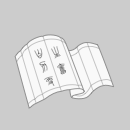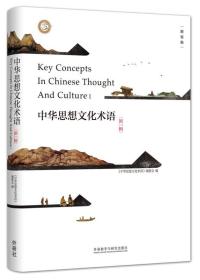
中华思想文化术语:文艺卷(中英对照)
全新正版 极速发货
¥ 83.51 6.1折 ¥ 138 全新
库存2件
作者《中华思想文化术语》编委会
出版社外语教学与研究出版社
ISBN9787521325430
出版时间2021-05
装帧精装
开本其他
定价138元
货号1202332444
上书时间2025-01-09
- 最新上架
商品详情
- 品相描述:全新
- 商品描述
-
商品简介
《中华思想文化术语:文艺卷(中英对照)》以学生和教师等群体为读者对象,为其研读、理解和翻译中华思想文化相关内容提供准确权威、正本清源的参考。全书收录300条文艺类中华传统思想文化核心词,按中文条目拼音排序以便于查找,并附有多种索引以满足不同需求。这些术语反映了中国传统文化特征和民族思维方式,体现了中国核心价值,编写者用易于口头表达、交流的简练语言客观准确地予以诠释,目的是在政府机构、社会组织、传播媒体等对外交往活动中,传播好中国声音,讲好中国故事,让世界更多了解中国国情、历史和文化。
《中华思想文化术语:文艺卷(中英对照)》一书是“中华思想文化术语传播工程”(以下简称“工程”)的成果之一。“工程”经国务院批准设立,建立了由、国家语委作为召集单位,中央编译局、中国外文局、外交部、民政部、文化部、新闻出版广电总局、国务院新闻办、新华社、中国科学院、中国社会科学院等十个部委(单位)为成员的部际联席会议机制,并聘请了权威专家成立顾问组、专家委员会、学术委员会,制定中华思想文化术语遴选与译写规则和标准,开展遴选与译写工作,发布译写成果及规范应用等。秘书处设在北京外国语大学外语教学与研究出版社。
作者简介《中华思想文化术语》编委会由韩震等人组成。
韩震,北京师范大学学术委员会主任、教授。
袁济喜,中国人民大学国学院教授,中国人民大学孔子研究院学术委员,北京大学美学与美育研究中心客座教授。
王博,北京大学副校长、教授,北京大学儒学研究院院长、道家研究中心主任。
聂长顺,武汉大学中国传统文化中心教授、日本研究中心学术企划部部长。
黄友义,曾任国际翻译家联盟副主席、外文局副局长兼总编辑、中国翻译协会秘书长,现任中国翻译协会副会长、全国翻译资格(水平)考试英语专家委员会主任。
目录1 āidiào 哀吊
Essay of Mourning and Essay of Memory ………… 1
2 āijǐng-xiělè 哀景写乐
Depict Sorrowful Scenery to Express Happiness ………… 3
3 bāyīn-kèxié 八音克谐
Harmonious Combination of Eight Sounds ………… 4
4 báimiáo 白描
Plain Line Drawing ………… 5
5 bǎixì 百戏
Baixi(All Performing Arts) ………… 7
6 bēikǎi 悲慨
Depressed and Enraged ………… 8
7 běiqǔ 北曲
Northern Opera ………… 10
8 běnsè 本色
Bense (Original Character) ………… 12
9 bǐdé 比德
Virtue Comparison ………… 15
10 biānsàishī 边塞诗
Frontier Poetry ………… 16
11 biàntǐ 辨体
Style Differentiation ………… 17
12 biāojǔ-xìnghuì 标举兴会
Distinctiveness and Spontaneity ………… 19
13 biécái-biéqù 别材别趣
Distinct Subject and Artistic Taste ………… 21
14 biéjí别集
Individual Collection ………… 23
15 bù nián bù tuō, bù jí bù lí 不黏不脱,不即不离
Neither Obsessed with Nor Detached from the Objects Depicted ………… 24
16 bùpíngzémíng 不平则鸣
Cry Out Against Injustice ………… 26
17 bù shè lǐlù, bù luò yánquán 不涉理路,不落言筌
Dispense with Theory and Logic; Take Care Not to Fall into Traps of Language ………… 28
18 bùsìzhīsì 不似之似
Dissimilar in Form but Similar in Spirit ………… 29
19 bù xué 《shī》, wú yǐ yán 不学《诗》,无以言
You Won’t Be Able to Talk Properly with Others Without Studying The Book of Songs. ………… 32
20 cǎoshū 草书
Cursive Script ………… 33
……
141 nóngdàn 浓淡
Denseness and Lightness ………… 227
142 piāoyì 飘逸
Natural Grace ………… 228
143 pǐntí 品题
Make Appraisals ………… 229
144 qízhèng 奇正
Qi or Zheng (Surprise or Normal) ………… 231
145 qìgǔ 气骨
Qigu (Emotional Vitality and Forcefulness) ………… 233
146 qìxiàng 气象
Prevailing Features ………… 235
147 qìyùn 气韵
Artistic Appeal ………… 236
148 qiānxiǎnɡ-miàodé 迁想妙得
Inspirational Creation Based on Association in Thinking ………… 238
149 qiǎozhuō 巧拙
Cleverness and Clumsiness ………… 240
150 qīngcí-lìjù 清词丽句
Refreshing Words and Exquisite Expressions ………… 242
151 qínɡfāyúshēnɡ 情发于声
Feelings Find Expression in Musical Poetry. ………… 243
152 qínɡ jiān yǎyuàn 情兼雅怨
A Mixed Quality of Grace and Sorrow ………… 244
153 qínɡjiào 情教
Moral Instruction Carried Out with Emotion ………… 246
154 qíngjǐng 情景
Sentiment and Scenery ………… 248
155 qíng yǐ wù qiān, cí yǐ qíng fā 情以物迁,辞以情发
Feeling Varies with Scenery and Verbal Expression Arises from Feeling. ………… 249
156 Qū-Sòng 屈宋
The Qu-Song Duo ………… 251
157 qǔ 曲
Qu (Melody) ………… 252
158 qǔjìnɡ 取境
Qujing (Conceptualize an Aesthetic Feeling) ………… 254
159 qù 趣
Qu ………… 255
160 quànbǎi-fěngyī 劝百风一
Much Blandishment and Little Criticism ………… 257
……
281 zhāngjù 章句
Textual Components / Annotation Work ………… 452
282 zhàocè 诏策
Imperial Edicts ………… 454
283 zhèngshēng 正声
Proper Music / Finest Poetry ………… 456
284 Zhènɡshǐ tǐ 正始体The Zhengshi Literary Style ………… 457
285 zhènɡshēnɡ 郑声
The Music of the State of Zheng ………… 458
286 zhīyīn 知音
Resonance and Empathy ………… 460
287 zhíxún 直寻
Direct Quest ………… 461
288 zhǐchǐ yǒu wànlǐ zhī shì 咫尺有万里之势
Power of Landscape Within Inches ………… 462
289 zhìlè-wúlè 至乐无乐
Utmost Happiness Lies in Not Aware of the Happiness. ………… 465
290 zhìshìzhīyīn 治世之音
Music of an Age of Good Order ………… 466
291 zhūgōngdiào 诸宫调
Song-speech Drama ………… 467
292 zhǔ wén ér jué jiàn 主文而谲谏
Admonition Through Tactful Wording ………… 469
293 zhùméng 祝盟
Benediction and Vow of Allegiance ………… 470
294 zhuǎnyì-duōshī 转益多师
Learn from Many Masters, and Form Your Own Style ………… 472
295 zīwèi 滋味
Nuanced Flavor ………… 474
296 zǐzhīduózhū 紫之夺朱
Purple Prevailing over Red ………… 475
297 zìrán-yīngzhǐ 自然英旨
Charm of Spontaneity ………… 476
298 zǒngjí 总集
General Collection / Anthology ………… 478
299 zòuqǐ 奏启
Memorial or Statement to Present One’s View to the Emperor ……… 480
300 zūnbēi-biǎntiè 尊碑贬帖
Praising Stone Inscriptions while Belittling Copying from tone Rubbings ………… 482
附录 Appendices
中国历史年代简表 A Brief Chronology of Chinese History ………… 484
人名索引 Index of Names ………… 486
著作名索引 Index of Cited Works ………… 493
术语条目笔画索引 Concepts Listed in Order of Number of Strokes ………… 505
【书摘与插画】选体 /《Xuǎn》 tǐ, xuǎntǐ
Xuanti Poetry / Poetry in Prince Zhaoming’s Favorite Style
主要指南朝梁昭明太子萧统(501 — 531)《文选》中所收汉魏以来的五言古诗。但这一概念后来超越了单纯的诗歌体式而兼具时代特征与诗歌风格等含义。在体式上,“选体”是与乐府、歌行、律绝并列的概念,在古人眼光中,它几乎就是五言古诗的代名词,是诗家创作五古的范式;在风格上,“选体”有典雅、翰藻、新创三个主要特征;从时代看,“选体”接续风骚,历跨汉魏、晋宋、齐梁。唐代以后,文论家多用“选体”这一术语来评诗、论诗。但“选体”派强调模仿古人,为此受到后来一些锐意创新的文人的批评。
This refers mainly to the five-character-a-line poems of the Han and Wei dynasties in Selections of Refined Literature compiled by Xiao Tong (501-531), Crown Prince Zhaoming of the Liang Dynasty during the Southern Dynasties. Later, this term meant not just a specific type of poetry, but also both the prevailing poetic features of an era and general poetic style. Poems of this style were regarded as in the same rank as yuefu (乐府) poetry, which were folk songs and ballads collected and compiled by the Han government office in charge of musical preservation, or any poetic imitation equally suitable for musical composition, as well as gexing (歌行), which were odes to events or physical objects in free-verse form, and lüjüe (律绝), or poetry with fixed patterns. To poetic critics in later generations, xuanti (选体) poetry was synonymous with five-character poetry and was a standard way to write poems with five characters per line. In terms of style, it is elegant, richly colorful, and innovative. This type of poetry inherited the poetic tradition all the way from The Book of Songs and Odes of Chu to the Han and Wei dynasties, the Jin Dynasty, and the Song, Qi, and Liang during the Southern Dynasties. From the Tang Dynasty onward, many literary critics used the term “xuanti poetry” as a standard in their comments on poetry. This poetic style was criticized later by some creative-minded poets for its excessive emphasis on following the classical tradition.
引例 Citations:
◎五言诗,三百五篇中间(jiàn)有之,逮汉魏苏、李、曹、刘之作,号为“《选》体”。(刘克庄《林子(xiǎn)》)
(五言诗在《诗经》中只是间或出现,到汉魏时期苏武、李陵、曹操、刘桢等人的创作[才得以定形,又因《文选》收录,故而]被称为“《文选》体”。)
Five-character-a-line poems were found occasionally in The Book of Songs. By the Han and Wei dynasties, Su Wu, Li Ling, Cao Cao, and Liu Zhen had written more five-character-a-line poems and established the style. These poems were collected in Selections of Refined Literature and therefore the style is known as the xuanti style. (Liu Kezhuang: Preface to A Collection of Poems by Lin Zixian)
◎昭明选古诗,人遂以其所选者为“古诗”,因而名古诗曰“选体”。唐人之古诗曰“唐选”。呜呼!非惟古诗亡,几并古诗之名而亡之矣。(钟惺《诗归·序》)
(昭明太子选古诗,后人于是把他所选的诗称为古诗,因此就称古诗为“选体”。唐代人创作的古诗叫做“唐选”。可惜啊!不仅古诗消亡了,就连“古诗”这一名称也跟着消亡了。)
Prince Zhaoming selected ancient poems, which people of later generations would call “ancient poems.” They were also known as xuanti poetry or poetry in Prince Zhaoming’s favorite style. The works by Tang-dynasty poets were called Tang xuanti poetry. But now, alas, ancient poetry has become extinct; even the term itself is sadly forgotten. (Zhong Xing: Preface to The Purport of Poetic Creation)
相关推荐
— 没有更多了 —




























以下为对购买帮助不大的评价